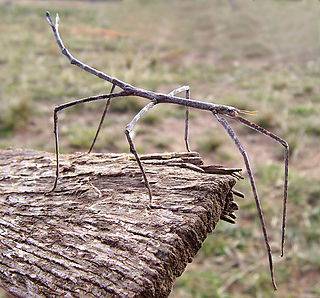
The Phasmatodea are an order of insects whose members are variously known as stick insects, stick-bugs, walkingsticks, stick animals, or bug sticks. They are also occasionally referred to as Devil's darning needles, although this name is shared by both dragonflies and crane flies. They can be generally referred to as phasmatodeans, phasmids, or ghost insects, with phasmids in the family Phylliidae called leaf insects, leaf-bugs, walking leaves, or bug leaves. The group's name is derived from the Ancient Greek φάσμα phasma, meaning an apparition or phantom, referring to their resemblance to vegetation while in fact being animals. Their natural camouflage makes them difficult for predators to detect; still, many species have one of several secondary lines of defense in the form of startle displays, spines or toxic secretions. Stick insects from the genera Phryganistria, Ctenomorpha, and Phobaeticus include the world's longest insects.

Phobaeticus serratipes is a species of stick insect that at one time was the longest known insect, with one female specimen recorded as being 55.5 cm (21.9 in) in total length. This measurement includes the legs fully extended front and rear, and the actual length of the body alone is considerably shorter. This insect is endemic to Peninsular Malaysia, Singapore and Sumatra. It is a popular species among those who raise insects.

The Euphasmatodea, also known by its junior synonym Verophasmatodea is a suborder of the Phasmatodea, which contains the vast majority of the extant species of stick and leaf insects, excluding the Timematodea. The oldest record of Euphasmatodea is Araripephasma from the Crato Formation of Brazil, dating to the Aptian stage of the Early Cretaceous.

Megacrania batesii, commonly known as the peppermint stick insect, is an unusual species of stick insect found in northeastern Australia, the Bismarck Archipelago, the Solomon Islands, New Guinea, and possibly as far north as the Philippines. It is notable for its aposematic coloration, as well as its robust chemical defense mechanism. Its common name refers to the irritating fluid — with an odor resembling peppermint — that it sprays as a defensive action from a pair of glands located at its prothorax when threatened, as well as the cylindrical, twig-like shape of its body. A member of the subfamily Megacraniinae, it was first described by English naturalist and explorer Henry Walter Bates in 1865.

The Phasmatinae are a subfamily of stick insects in the family Phasmatidae. They contain at least three tribes; Bradley and Galil corrected the spelling to "Phasmatinae" and provides a key to tribes.

Diapheromeridae is a family of stick insects. They belong to the superfamily Anareolatae of suborder Verophasmatodea.
Phobaeticus chani, the Chan's megastick, is a species of stick insect in the tribe Pharnaciini, native to the southeast Asian island of Borneo. It is one of the longest insects in the world and was once considered the record-holder. One specimen held in the Natural History Museum in London measures 56.7 cm (22.3 in). This measurement is, however, with the front legs fully extended. The body alone still measures an impressive 35.7 cm (14.1 in).

Ctenomorpha marginipennis, the margin-winged stick insect, is a species of stick insect endemic to southern Australia. The species was first described by George Robert Gray in 1833.
Asceles is a genus of stick insects in the tribe Necrosciini. Some of the species of Asceles have a distribution in Malaysia and Singapore.

Diapheromerinae is a subfamily of the stick insect family Diapheromeridae. They belong to the superfamily Anareolatae of suborder Verophasmatodea.

Diapheromerini is a tribe of walkingsticks in the family Diapheromeridae. There are at least 30 genera Diapheromerini.

The Lonchodinae are a subfamily of stick insects in the family Lonchodidae found in: Australasia, Asia, Africa, Southern America and the Pacific.

Lonchodidae is a family of stick insects, with more than 150 genera and 1,000 described species.

Phasmatini is a tribe of stick insects in the family Phasmatidae. There are more than 40 described species, found in Australasia, and Asia

Phasmotaenia lanyuhensis is a species of stick insect, order Phasmatodea. It is endemic to Taiwan. It is often included in the family Phasmatidae, although sometimes excluded from it when the family is strictly delimited. It derives its specific name from its type locality, Lanyuh Island, commonly known as Orchid Island.

Heteropterygini is the only tribe within the subfamily of the Heteropteryginae. With 19 representatives described, this subfamily includes the fewest species of the three subfamilies, but includes the largest and most striking species of the family.

Phasma gigas is a large-sized stick insect found in Maluku Islands, Gorong Islands and Kei Islands. It is often believed that Phasma gigas is present on New Guinea, but in fact, all New Guinean records actually refer to Phasma reinwardtii. Furthermore, the historic records from Sulawesi are doubtful and need more evaluation.
Anchiale marmorata is a medium-sized stick insect found in Papua New Guinea. This species is very similar to A. modesta but females are smaller in size and have shorter legs.
Anchiale simplex is a medium-sized stick insect. The existence of this species is questionable. It was described from a single female from French Polynesia in the Museum of Natural History of Vienna, but close examination by entomologist, Frank Hennemann, of the holotype in the Museo Civico di Storia Naturale revealed this species to be too similar to Anchiale stolli from the Bismarck Archipelago and Solomon Islands. Further research is needed.

Frank H. Hennemann is a German entomologist and taxonomist who works in the field of biodiversity research on the systematics and biogeography of stick insects (Phasmatodea).















